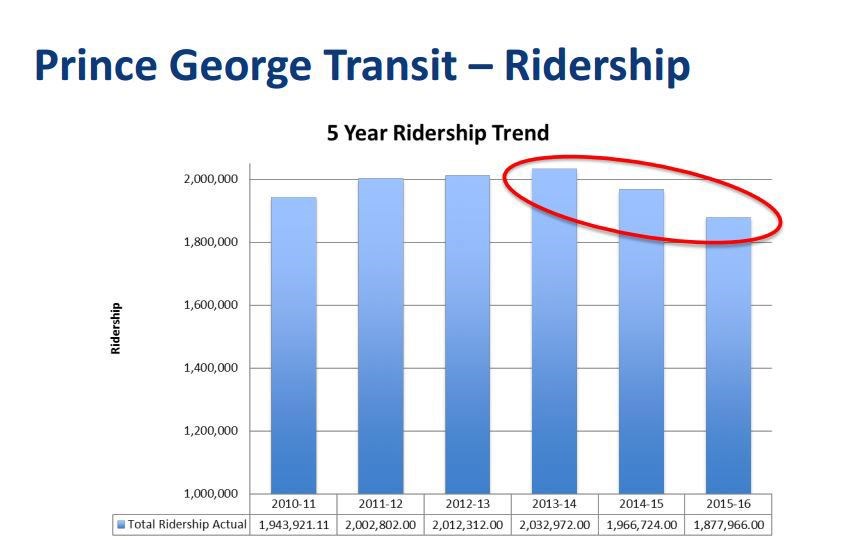Amid falling ridership and years without service improvements, council approved a 6.5 per cent budget increase for its transit system.
The funding for transit is through cost-sharing between the city and the province, with Prince George taking on 53.31 per cent and BC Transit with 46.69 per cent.
This year's increase to the net municipal share - $147,650 for 2016 and 2017 - was tacked on to last year's total of $2,120,105 for the city's share. The province is projected to kick in $3,186,103.
"It is an increase above what is tolerable," said Coun. Albert Koehler, before councillors unanimously voted in favour.
Council also approved budgets for the custom system and community bus.
Coun. Susan Scott recused herself from the discussions.
The regularly scheduled, "fixed route" vehicles are operated by a local contractor, Prince George Transit Ltd. The increase was due to inflationary increase attached to the company's fixed costs, an increase in driver wage benefits and an increase in service hours with less statutory holidays, a staff report said.
The last two years have seen a drop in users since a peak in 2013 and 2014 reported 2,032,972 rides. Last year there were 155,006 less rides than that peak from its 15 routes, or an almost eight per cent dip in ridership.
A drop is common after fare increases, which happened in January 2014, senior regional transit manager Chris Fudge told council Monday night.
"We do know anecdotally that enrollment is down at UNBC, so with a system that does rely very heavily on U-Pass revenue ridership, that is going to make a difference in the system," said Fudge, calling the drop an "area of concern."
The stall in service improvements is also likely to blame, but Fudge said Prince George's system compares well to those in its category - like Kelowna, Kamloops and Nanaimo - especially in the customer service and timing categories.
"I believe it's a system that could benefit greatly from more attention," Fudge said.
While Prince George takes home all revenue, which ranges from 30.6 to 32.6 per cent cost recovery, Fudge said it's not performing as well on that front.
Longtime transit advocate Coun. Jillian Merrick said many were frustrated by last year's announcement BC Transit would essentially freeze funding for three years.
Two years ago Prince George approved its transit future plan, a fact that prompted a back-and-forth been Merrick and Shilpa Panicker, Senior Transit Planner.
"We're two and a half years later and I'm just wondering why no next steps have been taken, why we haven't done a planning activity?" Merrick asked Panicker. "I'm just wondering why it's been stalled for two and a half years."
"(The) reason there hasn't been any additional activity taking place because we at BC Transit had absolutely no funding for the past two years," Panicker replied.
"Without an increase in service hours it was not possible to undertake any additional service improvements."
"I appreciate that but it's ... not about the service improvements but why we haven't done the planning activities?" Merrick said.
Panicker first said it was "it was just a matter of having the funds available" but later clarified that while some planning has been done, it's been two years and it would still need to review the system again.
"We'd like to look at how the system's performing and make some tweaks if it's required in the performance of the system before implementing the recommendations."
Some of those recommendations include offering service on statutory holidays, increasing HandyDART service, and more busses on routes that could be candidates for future rapid transit, like routes 15, 16, 88 and 89.
Further down the road Panicker talked about rapid transit, building a bigger facility and making a transit hub in the downtown core.
"It's a branding thing, it's a visioning thing for the current system," Panicker said. "It creates a presence for the transit system in the downtown."



